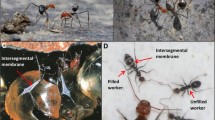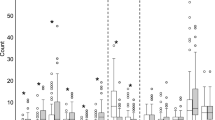Abstract
Social insect societies are considered to be composed of many extremely cooperative individuals. While workers are traditionally believed to behave altruistically, recent studies have revealed behaviors that are more selfish. One such example is intraspecific social parasitism, where workers invade conspecific colonies and produce male offspring that are reared by unrelated host workers. Such intraspecific parasitism has been reported in honeybees (Apis cerana, and A. florea) and “semi-wild” bumblebee colonies of Bombus terrestris. Here we report on intraspecific social parasitism by workers in “wild” colonies of the bumblebee B. deuteronymus. Three of the 11 B. deuteronymus colonies studied were invaded by non-natal workers, of which 75% became reproductive and produced 19% of the adult males. The invading non-natal workers produced significantly more males than resident natal workers and the non-natal brood was not discriminated against by the natal workers.
Similar content being viewed by others
References
Alaux C, Savarit F, Jaisson P, Hefez A (2004) Does the queen with it all? Queen-worker conflict over male production in the bumblebee, Bombus terrestris. Naturwissenschaften 91:400–403
Asada S, Ono M (2000) Difference in colony development of two Japanese bumblebees, Bombus hypocrita and B. ignitus (Hymenoptera: Apidae). Appl Entomol Zool 35:597–603
Beekman M, Oldroyd BP (2008) When workers disunite: intraspecific parasitism by eusocial bees. Annu Rev Entomol 53:19–37
Birmingham AL, Winston ML (2004) Orientation and drifting behaviour of bumblebees (Hymenoptera: Apidae) in commercial tomato greenhouses. Can J Zool 82:52–59
Birmingham AL, Hoover SE, Winston ML, Ydenberg RC (2004) Drifting bumble bee (Hymenoptera: Apidae) workers in commercial greenhouses may be social parasites. Can J Zool 82:1843–1853
Boomsma JJ, Ratnieks FLW (1996) Paternity in eusocial Hymenoptera. Philos Trans R Soc Lond B 351:947–975
Bourke AFG, Ratnieks FLW (1991) Kin-selected conflict in the bumble-bee Bombus terrestris (Hymenoptera: Apidae). Proc R Soc Lond B 268:347–355
Brown MJF, Bear B, Schmid-Hempel R (2002) Dynamics of multiple mating in the bumble bee Bombus hypnorum. Insect Soc 49:315–319
Brown MJF, Schmid-Hempel R, Schimd-Hempel P (2003) Queen-controlled sex ratios and worker reproduction in the bumble bee Bombus hyponorum, as revealed by microsatellites. Mol Ecol 12:1599–1605
Cnaani J, Schmid-Hempel R, Schmidt JO (2002) Colony development, larval development and worker reproduction in Bombus impatiens Cresson. Insectes Soc 49:158–163
Crozier RH, Page RE (1985) On being the right size: male contributions and multiple mating in the social Hymenoptera. Behav Ecol Sociobiol 18:105–115
Crozier RH, Pamilo P (1996) Evolution of social insect colonies. Sex allocation and kin selection. University of Oxford Press, Oxford
Estoup A, Scholl A, Pouvreau A, Solignac M (1995) Monoandry and polyandry in bumble bees (Hymenoptera-Bombinae) as evidenced by highly variable microsatellites. Mol Ecol 4:89–93
Foster KR, Ratnieks FLW (2001) Paternity, reproduction and conflict in vespine wasps: a model system for testing kin selection predictions. Behav Ecol Sociobiol 50:1–8
Foster KR, Seppa P, Ratnieks FLW, Thorén PA (1999) Low paternity in the hornet Vespa crabro indicates that multiple mating by queens is derived in vespine wasps. Behav Ecol Sociobiol 46:252–257
Foster KR, Ratnieks FLW, Raybould AF (2000) Do hornets have zombie workers? Mol Ecol 9:735–742
Goodnight KF, Queller DC (1994) Relatedness 4.2. Goodnight Software, Houston
Hughes WOH, Oldroyd BP, Beekman M, Ratnieks FLW (2008) Ancestral monogamy shows kin selection is key to the evolution of eusociality. Science 320:1213–1216
Jay SC (1965) Drifting of honeybees in commercial apiaries. I. Effects of various environmental factors. J Apic Res 4:167–175
Katayama E, Takamizawa K, Ochiai H (1993) Supplementary notes on the nests of some Japanese bumblebees III. Bombus (Thoracobombus) deuteronymus maruhanabachi. Jpn J Entomol 61:749–761
Kikuta N, Tsuji K (1999) Queen and worker policing in the monogynous and monandrous ant, Diacamma sp. Behav Ecol Sociobiol 46:180–189
Lopez-Vaamonde C, Koning JW, Brown RM, Jordan WC, Bourke AFG (2004) Social parasitism by male-producing reproductive workers in a eusocial insect. Nature 430:557–560
Lopez-Vaamonde C, Brown RM, Lucas ER, Pereboom JJM, Jordan WC, Bourke AFG (2007) Effect of the queen on worker reproduction and new queen production in the bumblebee Bombus terrestris. Apidologie 38:171–180
Martin SJ, Beekman M, Wossler TC, Ratnieks FLW (2002) Parasitic Cape honeybee workers, Apis mellifera capensis, evade policing. Nature 415:163–165
Miller DG, Ratnieks FLW (2001) The timing of worker reproduction and breakdown of policing behaviour in queenless honeybee (Apis mellifera) societies. Insect Soc 48:178–184
Nanork P, Parr J, Chapman NC, Wongsiri S, Oldroyd BP (2005) Asian honeybees parasitize the future dead. Nature 437:829
Nanork P, Chapman NC, Wongsiri S, Lim J, Gloag RS, Oldroyd BP (2007) Social parasitism by workers in queen-less and queen-right Apis cerana colonies. Mol Ecol 16:1107–1114
Owen RE, Plowright RC (1982) Worker-queen conflict and male parentage in bumble bees. Behav Ecol Sociobiol 11:91–99
Paar J, Oldroyd BP, Huettinger E, Kastberger G (2002) Drifting of workers in nest aggregations of the giant honeybee Apis dorsata. Apidologie 33:553–561
Paxton RJ, Thorén PA, Estoup A, Tengö J (2001) Queen-worker conflict over male production and the sex ratio in a facultatively polyandrous bumblebee, Bombus hyponorum: the consequences of nest usurpation. Mol Ecol 10:2489–2498
Paxton RJ, Ayasse M, Field J, Soro A (2002) Complex sociogenetic organization and reproductive skew in a primitively eusocial sweat bee, Lasioglossum malachurum, as revealed by microsatellites. Mol Ecol 11:2405–2416
Payne CM, Laverty TM, Lachance MA (2003) The frequency of multiple paternity in bumble bee (Bombus) colonies based on microsatellite DNA at the B10 locus. Insect Soc 50:375–378
Pfeiffer KJ, Crailsheim K (1998) Drifting of honeybees. Insect Soc 45:151–167
Ratnieks FLW (1988) Reproductive harmony via mutual policing by workers in eusocial Hymenoptera. Am Nat 132:217–236
Sakagami SF, Katayama E (1977) Notes of some Japanese bumblebees (hymenoptera, Apidae). J Fac Sci Hokkaido Univ Ser VI Zool 21:92–153
Schmid-Hempel R, Schmid-Hempel P (2000) Female mating frequencies in Bombus spp. from Central Europe. Insect Soc 47:36–41
Sumner S, Lucas E, Barker J, Isaac NJB (2007) Radio-tagging technology reveals extreme nest drifting in a eusocial insect. Curr Biol 17:140–145
Takahashi J, Akimoto S, Hasegawa E, Nakamura J (2002) Queen mating frequencies and genetic relatedness between workers in the hornet Vespa ducalis (Hymenoptera: Vespidae). Appl Entomol Zool 37:481–486
Takahashi J, Ayabe T, Mitsuhata M, Shimizu I, Ono M (2008a) Diploid male production in a rare and locally distributed bumblebee, Bombus florilegus (Hymenoptera: Apidae). Insect Soc 55:43–50
Takahashi J, Itoh M, Shimizu I, Ono M (2008b) Male parentage and queen mating frequency in the bumblebee Bombus ignitus (Hymenoptera: Bombinae). Ecol Res 23:937–942
Visscher PK (1996) Reproductive conflict in honey bees: a stalemate of worker egg-laying and policing. Behav Ecol Sociobiol 39:237–244
Walsh PS, Metzger DA, Higuchi R (1991) Chelex 100 as a medium for simple extraction of DNA for PCR-based typing from forensic material. Biotechniques 10:506–513
Wenseleers T, Ratnieks FLW (2006) Enforced altruism in insect societies. Nature 444:50
Woyciechowski M, Lomnicki A (1987) Multiple mating queens and the sterility of workers among eusocial Hymenoptera. J Theol Biol 128:317–327
Acknowledgments
This study was supported by a Japan Society for the Promotion of Science research fellowship to J.T. and the PRO NATURA 2008 fund for bumblebee conservation. This research was financially supported in part by the Global COE Program A06 to Kyoto University.
Author information
Authors and Affiliations
Corresponding author
About this article
Cite this article
Takahashi, Ji., Martin, S.J., Ono, M. et al. Male production by non-natal workers in the bumblebee, Bombus deuteronymus (Hymenoptera: Apidae). J Ethol 28, 61–66 (2010). https://doi.org/10.1007/s10164-009-0155-y
Received:
Accepted:
Published:
Issue Date:
DOI: https://doi.org/10.1007/s10164-009-0155-y




